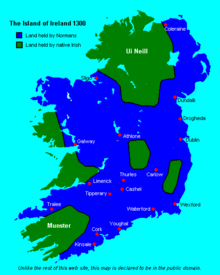
Back Hiberno-normandu AST Hiberno-normand Catalan Hiberno-Normannen German Hiberno-normando Spanish Hiberniar-normandiar Basque Hiberno-Normand French Hiberno-normannok Hungarian Hiberno-Normanni Italian Lingua Hiberno-Normannica Latin Hiberno-normando Portuguese
This article needs additional citations for verification. (May 2017) |

Hiberno-Normans, or Norman Irish (Irish: Normánach ; Old Irish: Gall, 'foreigners'), refer to Irish families descended from Norman settlers who arrived during the Anglo-Norman invasion of Ireland in the 12th century, mainly from England and Wales. During the High Middle Ages and Late Middle Ages, the Hiberno-Normans constituted a feudal aristocracy and merchant oligarchy, known as the Lordship of Ireland. The Hiberno-Normans were also closely associated with the Gregorian Reform of the Catholic Church in Ireland and were responsible for the emergence of Hiberno-English.
Some of the most prominent Hiberno-Norman families were the Burkes (de Burghs), Butlers, and FitzGeralds who over time were said to have become "more Irish than the Irish themselves" by merging culturally and intermarrying with the Gaels. One of the most common Irish surnames, Walsh, derives from Welsh Normans who arrived in Ireland as part of this group.
The dominance of the Hiberno-Normans declined during the 16th century after the Anglican "New English" elite settled in Ireland from the end of the Tudor period; and they came to be known as Seanghaill (Old English) at this time. Many Roman Catholic Norman-Irish families spread throughout the world as part of the Irish diaspora ceasing, in most cases, to identify as Norman, whether originally Anglo-Norman, Cambro-Norman, or Scoto-Norman. Other Old English families, like the Dillons, merged with the New English elite after the Henrician Reformation. Following the Glorious Revolution, many of these Old English families promoted unity with the Gaels under the denominator of "Irish Catholic", while others were assimilated into a new Irish Protestant identity, which also included later settler groups such as the Ulster Scots and Huguenots.
© MMXXIII Rich X Search. We shall prevail. All rights reserved. Rich X Search